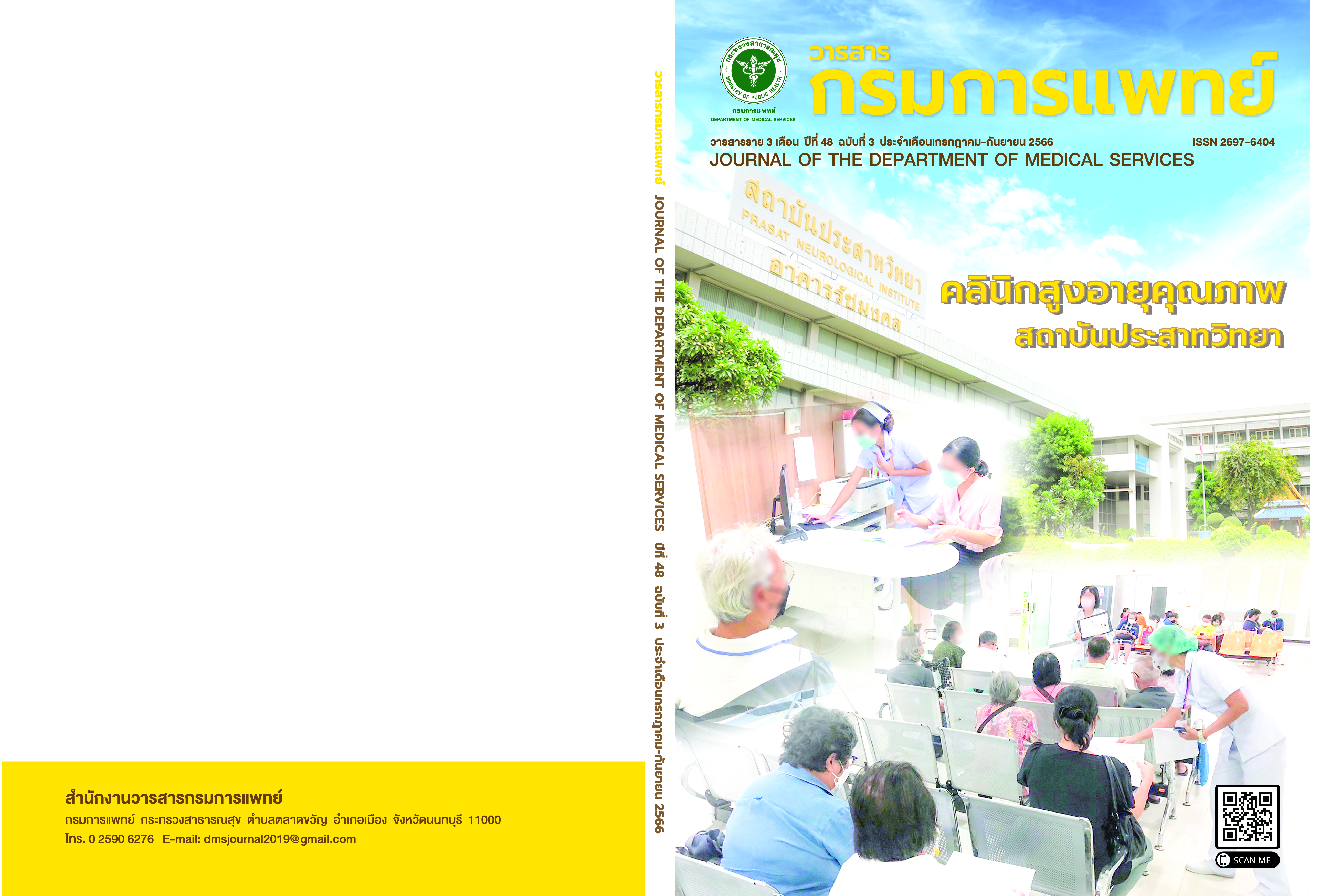Outcomes and Prognosis Prediction of Intermediate Phase Patients in Lampang Province
Keywords:
Intermediate care, Stroke, Traumatic brain injury, Spinal cord injury, Barthel indexAbstract
Background: Intermediate care service is an important part of the patient care process, especially in patients who have passed the critical period but still have abnormal body function or limited performance in day-to-day activities. Objective: This study aimed to examine functional outcomes and prognosis prediction after rehabilitation programs in intermediate care service in Lampang Province. Method: This study focused on prognostic research with a retrospective collection of data of 3 patient groups (stroke, traumatic brain injury and spinal cord injury) who received rehabilitation programs at public hospitals in Lampang (from 1 January 2019 to 31 December 2020). The Barthel index of each patient was collected before and after the rehabilitation period, which was about 6 months from the onset of illness. Results: The results of this study revealed that there was a total number of 1,216 patients (traced in intermediate care process) who participated in a rehabilitation program for 6 months. The Barthel index scored had an increase of 7.1 (95%CI 6.8, 7.5) on average after the rehabilitation. The total Barthel index score also showed a significant difference (p < .001) when analyzed among each intermediate care service pattern and among each initial functional ability group to perform day-to-day activities. Nevertheless, there was no significant difference in the total Barthel index score (p = .479) when analyzing each patient group (spinal cord injury, stroke, and traumatic brain injury). Conclusion: Rehabilitation programs in intermediate care service help increase the functional ability to perform daily life activities in patients, and they have significantly different results (among each intermediate care service pattern and in each initial functional ability group to perform adily life activities). The prognosis prediction model can be used to guide healthcare professionals and individuals regarding their decision on making further management. Finally, the result of this study may be used to improve intermediate care systems in Lampang province in the future.
References
International Health Policy Program Foundation. Burden of disease research program thailand 2017-2019. Nonthaburi: The Graphico Systems; 2021.
Siriyong W. Prevalence of Stroke and Stroke Risk Factors in Kanchanadit Hospital. Reg11MedJ 2018;32(1):863-70
Health Administration Division, Ministry of public health. Guideline for Intermediate Care (Service plan). [internet] 2019 [cited 2022]. Available from:https://phdb.moph.go.th/main/ index/detail/30103.
Thai Rehabilitation Medicine Association. Subacute rehabilitation. [internet] 2016 [cited 2022]. Available from: https://www.rehabmed.or.th/files/book.pdf.
Pipatsrisawat S. Outcomes of rehabilitation in intermediate phase of stroke patients. CMJ 2020;12(3):47-56.
Chiangchaisakulthai K. Intermediate Care. Nonthaburi: International Health Policy Program, Ministry of public health; 2019.
Pattanasuwanna P. Outcomes of intermediate phase post-stroke inpatient rehabilitation in community hospital. ASEAN J Rehabil Med 2019;29(1):8-13.
Srisubat A, O-charot L, Loharjun B, Siriwatvejakul U, Kuptniratsaikul V, Opachalermphan S. Cost-effectiveness of intermediate care (inpatient) in post-acute stroke compared with out-patient rehabilitation program. j dept med ser 2019; 44(5):167–73.
Kuptniratsaikul V, Wattanapan P, Wathanadilokul U, Sukonthamarn K, Lukkanapichonchut P, Ingkasuthi K, et al. The effectiveness and efficiency of inpatient rehabilitation services in thailand: A prospective multicenter study. Rehabil Process Outcome. 2016; 5:S34816.
Samintarapanya K. Cause death of stroke. Thai journal of Neurology 2021;37(3):6-14.
Coupland AP, Thapar A, Qureshi MI, Jenkins H, Davies AH. The definition of stroke. J R Soc Med 2017;110(1):9-12.
Sukonthamarn K. Rehabilitation of Traumatic Brain Injury. J Thai Rehabil 2002;11(3):84-97
Sirindhorn National Medical Rehabilitation Institute. Guideline for spinal cord injury patients (paraplegia). [internet] 2012 [cited 2022]. Available from: https://www.snmri.go.th/wp-content/ uploads/2021/01/04_paraplegia_book.pdf
Dajpratham P, Meenaphant R, Junthon P, Pianmanakij S, Jantharakasamjit S, Yuwan A. The inter-rater reliability of barthel index (thai version) in stroke patients. J Thai Rehabil 2006;16(1):1-9.
Prasat Neurological Institute. Clinical practice guidelines for stroke Rehabilitation. 1st ed. Bangkok: Prasat Neurological Institute; 2007.
Knief U, Forstmeier W. Violating the normality assumption may be the lesser of two evils. Behav Res Methods 2021; 53(6):2576–90.
Vittinghoff E, Shiboski SC, Glidden DV, McCulloch C. Regression Methods in Biostatistics: Linear, Logistic, Survival and Repeated Measures Models. New York:Springer; 2004.
Downloads
Published
How to Cite
Issue
Section
License
Copyright (c) 2023 Department of Medical Services, Ministry of Public Health

This work is licensed under a Creative Commons Attribution-NonCommercial-NoDerivatives 4.0 International License.
บทความที่ได้รับการตีพิมพ์เป็นลิขสิทธิ์ของกรมการแพทย์ กระทรวงสาธารณสุข
ข้อความและข้อคิดเห็นต่างๆ เป็นของผู้เขียนบทความ ไม่ใช่ความเห็นของกองบรรณาธิการหรือของวารสารกรมการแพทย์



